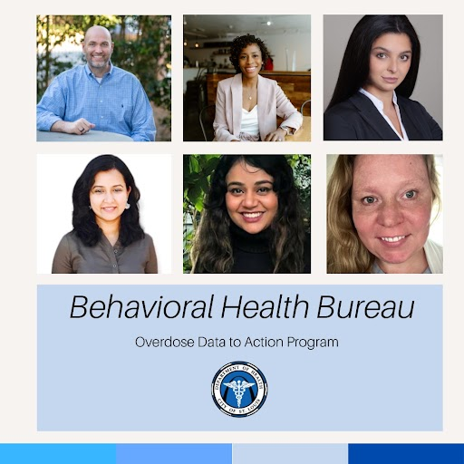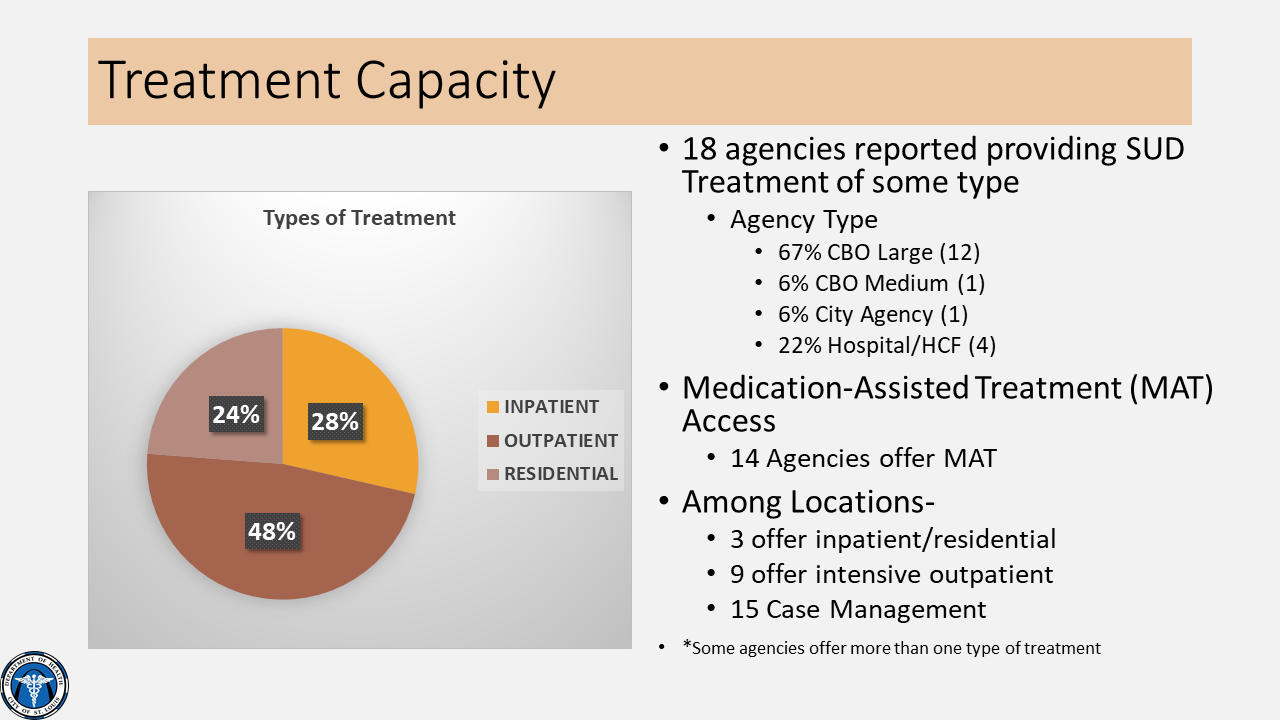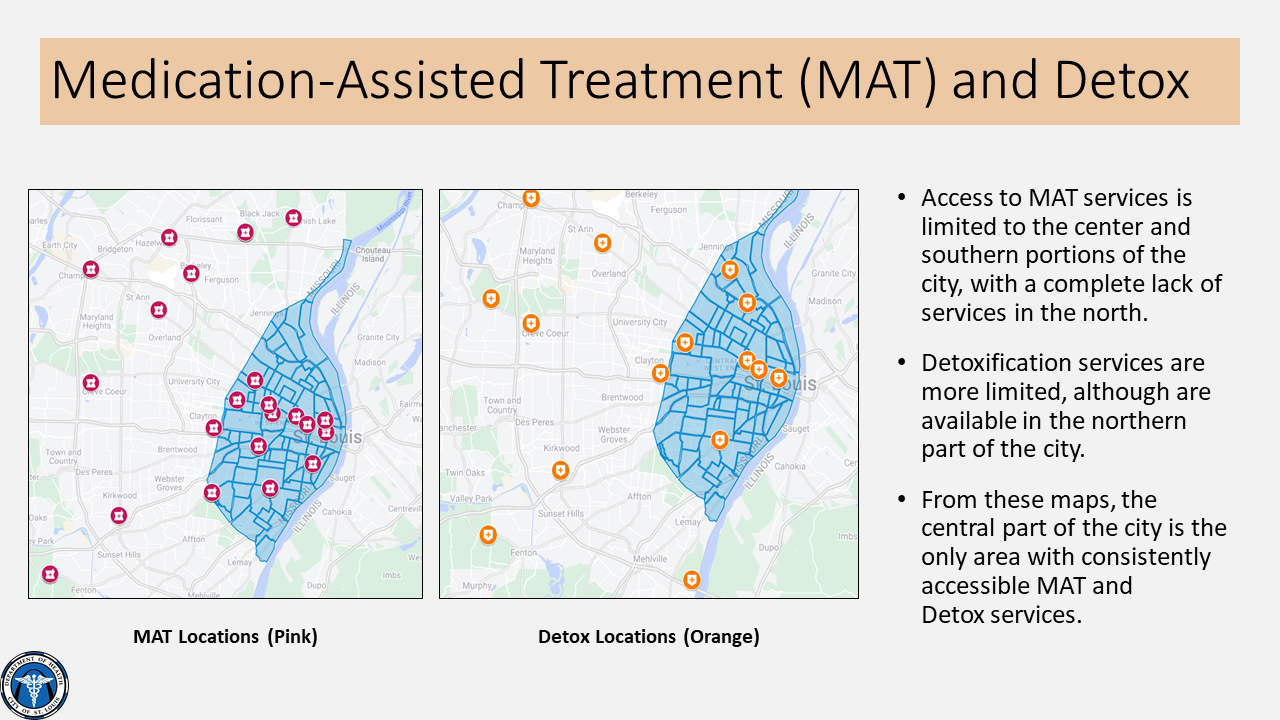Behavioral Health Snapshot
A Review of Substance Use Prevention, Harm Reduction, Treatment, & Recovery Activities in the City of St. Louis
The Snapshot is available in the following format:

On This Page
Background
The following information was gleaned through engaging with with local providers and community organization to gain a better understanding of substance use related prevention, treatment, and recovery activities in our community.
The data in the snapshot is not comprehensive for the City of St. Louis; it only reflects data reported to the OD2A team via their fall survey and data from the SAMHSA website. We know there are additional programs and services happening, but are limited to reporting what was reported.
What We’ve Done - Our Commitment
 When we introduced ourselves to you this past October, we had a long list of activities we hoped to accomplish. We are excited to share the first of those deliverables and to share
When we introduced ourselves to you this past October, we had a long list of activities we hoped to accomplish. We are excited to share the first of those deliverables and to share
with you an updated on the work we have been doing since that time.
- Introduced the new Bureau of Behavioral Health and the OD2A team.
- Developed and implemented a Community Assessment to better understand the City of St. Louis.
- Posted and began recruitment of 14 new positions to support the work of the new Bureau.
- Began in-depth data analysis of city data and worked with local partners to gain access to additional data that could be useful in monitoring and evaluation.
- Participated in Central Visual and Performing Arts High School (CVPA) shooting response; mapped the crisis response patterns of agencies to school district need.
- Held over 100 meetings with partners across the city and region to foster relationships and build rapport in the community.
- Formed the City of St. Louis Department of Health’s Opioid and Substance Use Task Force (S.O.S), a collaborative, cross-systems approach to combat the impact of substance use on families and the community.
- Hosted task-force meetings to glean community needs, engage in discussionbased planning, and identify gaps/barriers in services for SUD.
- Conducted a one-week site visit to St. Louis to further our understanding of the needs of the city to inform forthcoming planning and implementation
- Developed the Snapshot, a high-level community assessment. The matrix was designed to collect data from all different agencies and stakeholders in the City of St. Louis that work in overdose and substance use awareness, prevention, and treatment and show the scope of work in all these services/areas and what gaps exist.
- Created an Epidemiology Profile to highlight the burden of Substance Use Disorder (SUD) on the population/area of St. Louis in terms of socioeconomic, geographic, and behavioral factors. This helps capture how social determinants and upstream factors play into SUD.
- Developed a data dashboard, an interactive tool that showcases key metrics around substance use and overdoses. This tool will allow users the opportunity to click on certain rates to inquire about additional information.
- A behavioral health prevention and treatment services locator will also on the dashboard.
- Developing a strategic plan that will inform the implementation structure and efforts.
- Begin the planning stage of a series of culminating community-based summits in coming months to address substance use and high overdose rates.
- Secured funding allocated towards Request For Proposals (RFPs) to address behavioral health and substance use issues across the continuum of care.
- Conducted communication meetings to understand and identity needs across the DOH and the internal OD2A team
Key Findings
- Citywide gaps in equity and access to care, including insufficient provision of culturally relevant services to racial and ethnic minorities, language interpretation and translation services.
- Some communities in the city appear to lack easy access to culturally appropriate prevention, treatment, and/or recovery support services.
- Gaps in access to Medication Assisted Treatment exist throughout the city.
- Extreme concern around the lack of housing of all types-respite, transitional, and inpatient treatment.
- Lack of treatment and recovery supports in all areas of the city, specifically limited access in the northern and southern areas of the city.
- While many agencies reported prevention activities, there does not appear to be a good understanding of primary prevention and there is a lack of a comprehensive prevention program or framework related to substance use in the city.
- There does not appear to be a strong network to connect new, emerging, or smaller CBO’s to existing infrastructure for treatment, care, and supportive services; no group appears to be coordinating or convening the community providers together to address gaps, assure linkages, and that appropriate treatments are available.
Recommendations
- Create a city-wide coalition to introduce and connect care providers with a stronger network of care in the City of St. Louis.
- Create a network and plan to provide a more comprehensive structure for SUD prevention in the city, with an emphasis on primary prevention.
- Develop a plan to assure equitable access of linguistically and culturally relevant services.
- Address gaps in substance use disorder workforce, including both prescribers and credentialed staff providing essential services and recovery supports.
- Expand access to medication assisted treatment (MAT) for opioid use disorder through provider training, telemedicine, & mobile services.
- Prioritize strategies that target affordable housing, education, and employment to reduce risk of substance use disorders and their consequences and to support long term recovery.
- Increase the availability and accessibility of harm reduction efforts to decrease fatality rates and build trusting relationships with individuals who are actively using substances.
Prevention Findings 
- Significant areas of the city seem to lack prevention activities.
- Lack of a comprehensive prevention plan from any one agency.
- Lack of knowledge of prevention - There is confusion between harm reduction, treatment, and prevention activities.
- Of the reported activities, the menu of options and the intervention points are limited.
Treatment Capacity 
- 18 agencies reported providing SUD Treatment of some type
- Agency Type
- 67% CBO Large (12)
- 6% CBO Medium (1)
- 6% City Agency (1)
- 22% Hospital/HCF (4)
- Agency Type
- Medication-Assisted Treatment (MAT) Access
- 14 Agencies offer MAT
- Among Locations-
- 3 offer inpatient/residential
- 9 offer intensive outpatient
- 15 Case Management
- *Some agencies offer more than one type of treatment
Medication-Assisted Treatment (MAT) and Detox

Through the Snapshot community assesment, it was found:
- Access to MAT services is limited to the center and southern portions of the city, with a complete lack of services in the north.
- Detoxification services are more limited, although are available in the northern part of the city.
- From these maps, the central part of the city is the only area with consistently accessible MAT and Detox services.
Where we are going:
In the coming months, the team plans to continue discussion-based meetings as it works toward creating a strategic plan that the Department of Health can use as it continues to work with partners to address substance use and mental health in the city. The team is also planning community summits expected for the spring. The Department of Health will release more information on how to attend these summits as the coordination process is still underway.
Funds from the Missouri Department of Health and Senior Services (DHSS), a settlement from opioid manufacturers and the American Rescue Plan Act (ARPA) support the bureau’s work. For the current fiscal year, the Department of Health has secured approximately $400,000 from DHSS and nearly $565,000 from opioid settlement funds. In addition to these amounts, the department plans to use $2 million of ARPA funding to continue the work through 2026.
The OD2A team is only the kickstart of the bureau’s team of 14 staff members who will continue the work. The Department of Health is actively hiring, and the City of St. Louis Department of Personnel released applications in November for Public Health Education Coordinator and Public Health Educator. Additional positions will continue to be posted. All applications should be submitted through the Department of Personnel and can be found at www.stlouis-mo.gov/jobs.